FIGURE 1 | Flyer for IACAET events offered in October and November 2023.
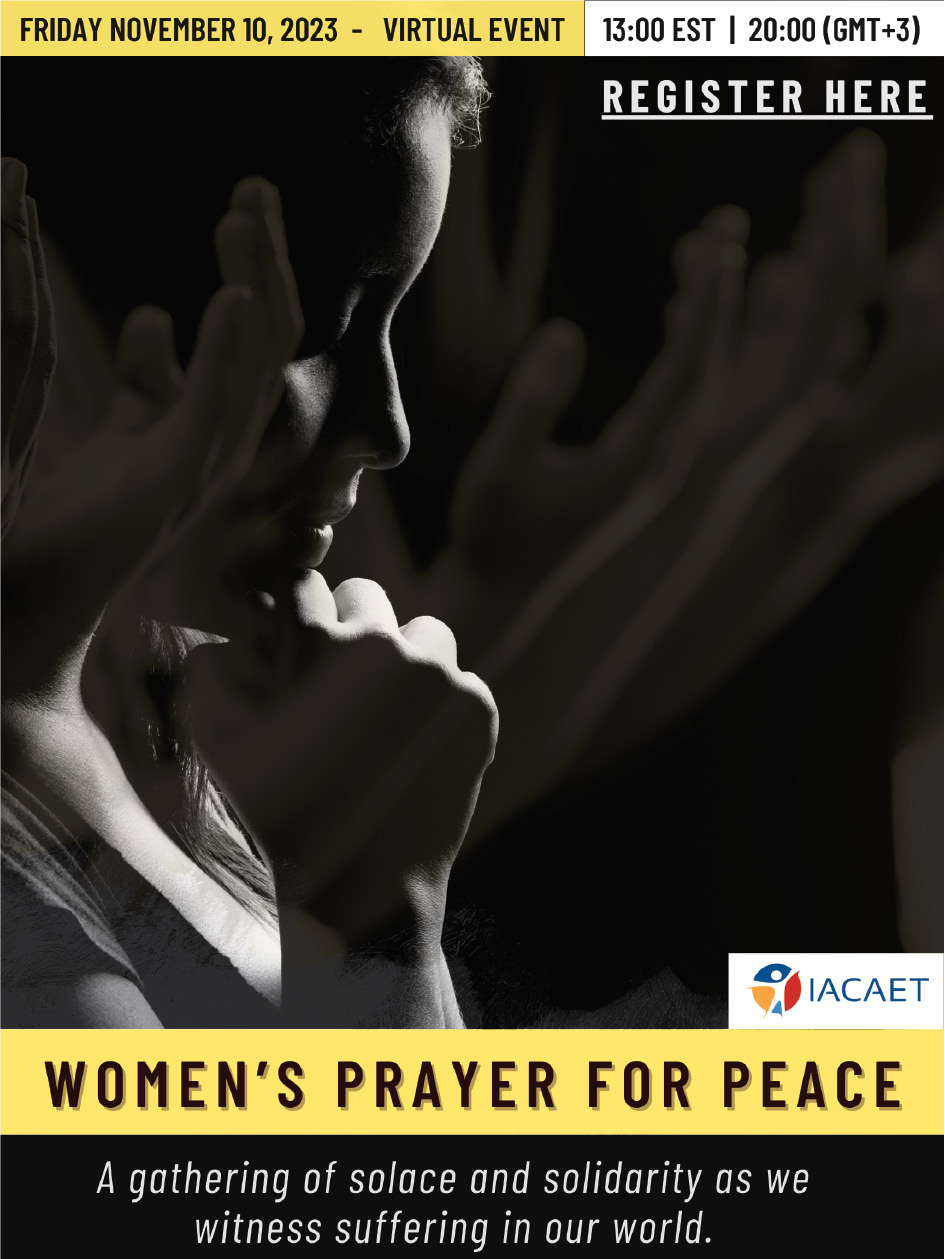
| Creative Arts Educ Ther (2024) 10(1):156–174 | DOI: 10.15212/CAET/2024/10/8 |
Art Encircles Life: Journeying With, In, and Through the Expressive Arts
艺术环抱生命 一 表达性艺术的旅程:相伴,沉浸与穿越
1University of the Witwatersrand, South Africa
2Lesley University, USA
Abstract
This article presents the work of two expressive arts therapists who traveled and taught around the world between February and April 2024. Our journey actually started on October 7, 2023, when we were supposed to start teaching in Israel, and instead found ourselves waking up into the barbaric outbreak of this new Israeli–Hamas war. Since that time and in the aftermath of a world forever marked by this tragedy and its aftermath, we have been searching for ways of being of service and engaging in and amplifying our understanding of the ways in which the arts contribute toward healing and the building of resilience in times of conflict, war, and disaster. During our journey, we teach in established creative and expressive arts therapy training programs in South Africa and India as well as teach in burgeoning and newly developing programs in Zambia and China. Wherever we go we are surrounded by the arts and arts practices and learn again about the lifesaving universality and importance of artistic expression.
Keywords: creative arts therapies, expressive arts therapy, expressive arts, creative process
摘要
本文介绍了两位表达性艺术治疗师在 2024 年 2 月至 4 月期间游历到世界各地的教学工作。我们的旅程实际上始于 2023 年 10 月 7 日。当时我们本应在以色列开始教学,但一觉醒来,却发现以色列和哈马斯爆发了新一轮的野蛮战争。从那时起,世界被这场悲剧及其后果永远烙上印记。我们一直寻找侍奉的方式,并研究如何运用艺术促进冲突、战争和灾难时期的愈合和复原力的建设。在这次旅程中,我们不仅在南非和印度这些已经建立了创造性和表达性艺术治疗领域的国家,也在赞比亚和中国这样的新兴蓬勃发展的国家中的培训项目中进行了教学。无论走到哪里,我们都被艺术和艺术实践所包围,并再次了解到艺术表达的普遍性、重要性及拯救生命的作用。
关键词: 创造性艺术治疗, 表达性艺术治疗, 表达性艺术, 创造性过程
Philosophical Underpinning to Our Work
According to Walsh (2001), the arts “help us search again not only for the meaning of life but also the purpose of our individual and collective experience… for ways we might re-create ourselves anew as a human species, so that we may end at last the cycle of violence that has marred our history.” (p. 17)
In this moment of history, much that has been known about our world has shifted. Most of the world is living in challenging and unprecedented times. The issues we are living through permeate local, regional, national, and global boundaries and channels. They are immediate and existential as we negotiate individual as well as global collective anxiety and trauma. Artists are familiar with living and working in this type of liminal space. The creative process involves learning to work with unknowns and ambiguities as part of the act of creation. In our work we hope to be able to continue to make a contribution toward the healing that needs to take place within ourselves and around our world as we move within and beyond these times.
We are always searching for ways to build bridges that cross social and ethnic boundaries and unite people through their common humanity and need for creative expression. We have done so in diverse cultures and across sensitive political divides. We are able to do this due to our personal determination to participate in promoting social justice and our belief in the arts as a catalyst for expression, communication, and change. Our work in pioneering these efforts around the world demonstrates our commitment to the full breadth of what the arts can offer in education, wellness, mental health, and public health. We have heard the expressions of joy and the cries of anguish of the human spirit, and our work has been in response to that call to attention and action.
We believe that both healing and art come out of attempts to make meaning from life’s beautiful and aesthetic spaces. However, it also comes out of the heavy spaces, the complex spaces, the contradictory spaces, and the things that are both finished and unfinished. The arts are the repository of the cultural legacies from the past and contain within them the seeds of hope for the future. All of our work has been guided by the belief that the arts are central to human experience (Dewey, 1934). We believe that the arts reveal metaphorical assumptions upon which we base our actions, and through this revelation explore alternative behaviors. Through the arts new connections can be made between individuals and groups as they exchange stories, perspectives, knowledge, and understanding. The arts allow for the development of empathy and an understanding of difference. It is through the development of empathic understanding of similarities and differences between self and others that relationships are formed, and children and adults can learn to tolerate and accept themselves and each other. Aesthetic-empathy is when we enlist and engage through the arts to help build healthy relationships toward healing. We believe that the complexities that individuals and communities are facing today call for creative- and soul-filled experiences that elicit hope and healing.
The artist, the storyteller, and the healer are what David Abram (1996) calls:
the magicians whose intelligence is not encompassed within the society; its place is at the edge of community, mediating between the human community and the larger community of beings.
(Abram, 1996, p. 6)
Artistic expressions and creative arts interventions are “boundaried” forms with a series of defined procedures that can lead to a wide variety of creative outcomes that can support people as they address traumatic experiences and a complex array of feelings. Engaging the Creative Process allows for a mobilization of resources including the emotional, social, spiritual, physical, and cognitive. The arts build bridges that cross social and ethnic boundaries and unite people. The arts manifest in intrapersonal, interpersonal, sociocultural, political-institutional, and spiritual domains (Speiser and Speiser, 2005, 2007a,b).
We believe that the arts play a significant role in the building of resilience and hope in troubled areas of the world, fostering empathic understanding, deep listening, connection, and equilibrium as a way of countering the destructive elements that arise from these local, national, and regional conflicts and differences. The language of art is a universal language that transcends barriers, speaking directly to and from the heart and allowing a space to express the gamut of emotions in the face of unbearable suffering. The arts can contribute toward the rebuilding of trust in a world marred by global disparities and ecological challenges as well as the disasters, conflicts, and disruptions of war.
Beginning with the War—October 2023
This journey began on October 7, 2023. We were supposed to be teaching in ONO Academic College and had just arrived in Israel the night before the war began. We woke up to the war in the morning. The barbaric horror of that moment is seared into our consciousness, and indeed into the collective consciousness, and these images will remain embedded in our hearts and souls for eternity. Every day since then, we operate within the backdrop of these inhumane life-destroying actions inflicted upon human beings. In the face of what has been unleashed since then, all we have to turn to and to offer is art and the making of art.
Soon after the war began, many of our friends and colleagues in Israel, who are creative arts therapists, began to volunteer to work with the people who had been displaced by the war. This displacement and work continues into the present moment. And we in the field will be learning from them as they research and practice the multitude of ways that the arts can be used to hold and to express all human emotions, to contain and manifest the complexity of duress, war, disaster, and inhumane acts of barbarity, and paradoxically at the same time to build connection and work toward the building of healing and resilience.
We were evacuated to Greece by the US State Department on the first evacuation flight out of Israel a week after the war began. Since then, we remain caught up in the vortex of that war, influenced by the news and media sources, as well as our connections to our friends and colleagues, our involvement within personal and professional arenas, and personally as Jews by the terrifying avalanche of antisemitism sweeping around the world. We find some small measure of solace in being part of communities who are gathering to find ways of holding the worldwide distress reactive to this war.
Soon after our return to the USA, Vivien worked with colleagues in IACAET (International Association for Creative Arts in Therapy and Education), Helen Payne and Devika Mehta, to host several global webinars where artists offered Women Led Prayers for Peace: A Gathering of Solace and Solidarity as We Witness Suffering in Our World. This was held in October and November 2023 (see Figure 1). We both continued our work with FAS, First Aid of the Soul Ukraine, in their ongoing work with the War in Ukraine, and we both joined the newly organized Association of Jewish Psychologists.
FIGURE 1 | Flyer for IACAET events offered in October and November 2023.

Travels and Teaching Around the World Starting in Greece—February 2024
Prior to the outbreak of the war, we had committed to worldwide professional engagements in 2024, and we decided to start our travels by returning to Greece as our starting point in late February 2024. We had at that time spent several months back in the USA. Our daily lives remained influenced and sometimes consumed by what we were hearing and seeing in our work and practice as well as by the news about the wars in the Middle East and Ukraine. At this point, some of the Israeli hostages had been released and there was a moment of hope and respite in their return and there was a feeling that the war might end. However, the stories about the horrors of being held captive began to emerge and these stories continue to unfold into the present moment. We are still holding our breath, hoping for the best and expecting the worst.
It was then cold and wintry where we live in Virginia in the USA as we departed on our travels. We begin a process that we had not predicted whereby we will no longer have access to much by the way of news from television and newspapers and what we do hear and see will become muted and muffled by the contexts of the countries we are moving through. We soon learned that without our daily dose of the news and attendant emotions about what was happening with the war we would need to find a different and possibly more healthy way of resourcing ourselves. And so, we turned away from the darkness of the war to the light of changing landscapes, changing seasons, to finding the heart of connection to others, to ways of being of service to others, and to exploring the art/s in every country and context we moved through. We resourced ourselves through art—and art nourished us over and over again.
When we arrived in Greece, in search of understanding and invoking inspiration, we travelled to the mountains and endless vistas of the Peloponnese and visited the sanctuary of Asklepios in Epidaurus, an early theater used also for healing, established in the 4th century BC (see Figure 3). This theatre has withstood the shocks of the planet and divine and human intervention since that time. We marvel as we hold the stones from this place in our hands, as we have done with objects we have gathered from other powerful sources, as we source their energy (see Figure 2). We begin to understand that we ourselves are engaged in a process of healing and regeneration as we embark on this journey, and we begin to gather new experiences and resources to support us in our lives and in our work.
FIGURE 2 | The stones from Epidaurus. Photo, Vivien Marcow Speiser Feb. 27, 2024.
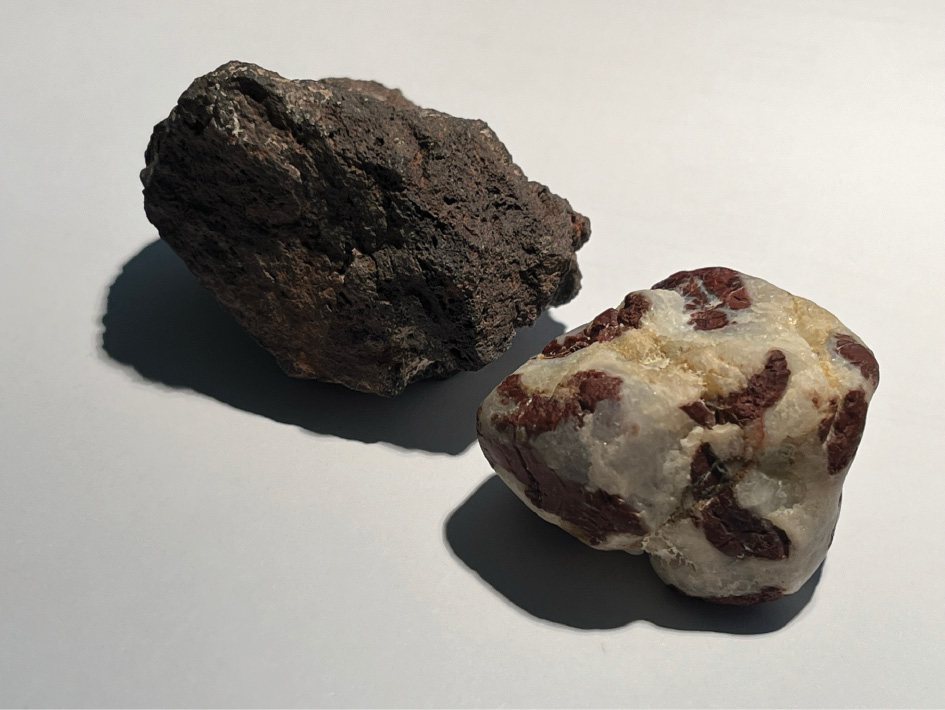
FIGURE 3 | Phillip standing in the still existent ancient theatre in Epidaurus. Photo, Vivien Marcow Speiseer Feb. 27, 2024.
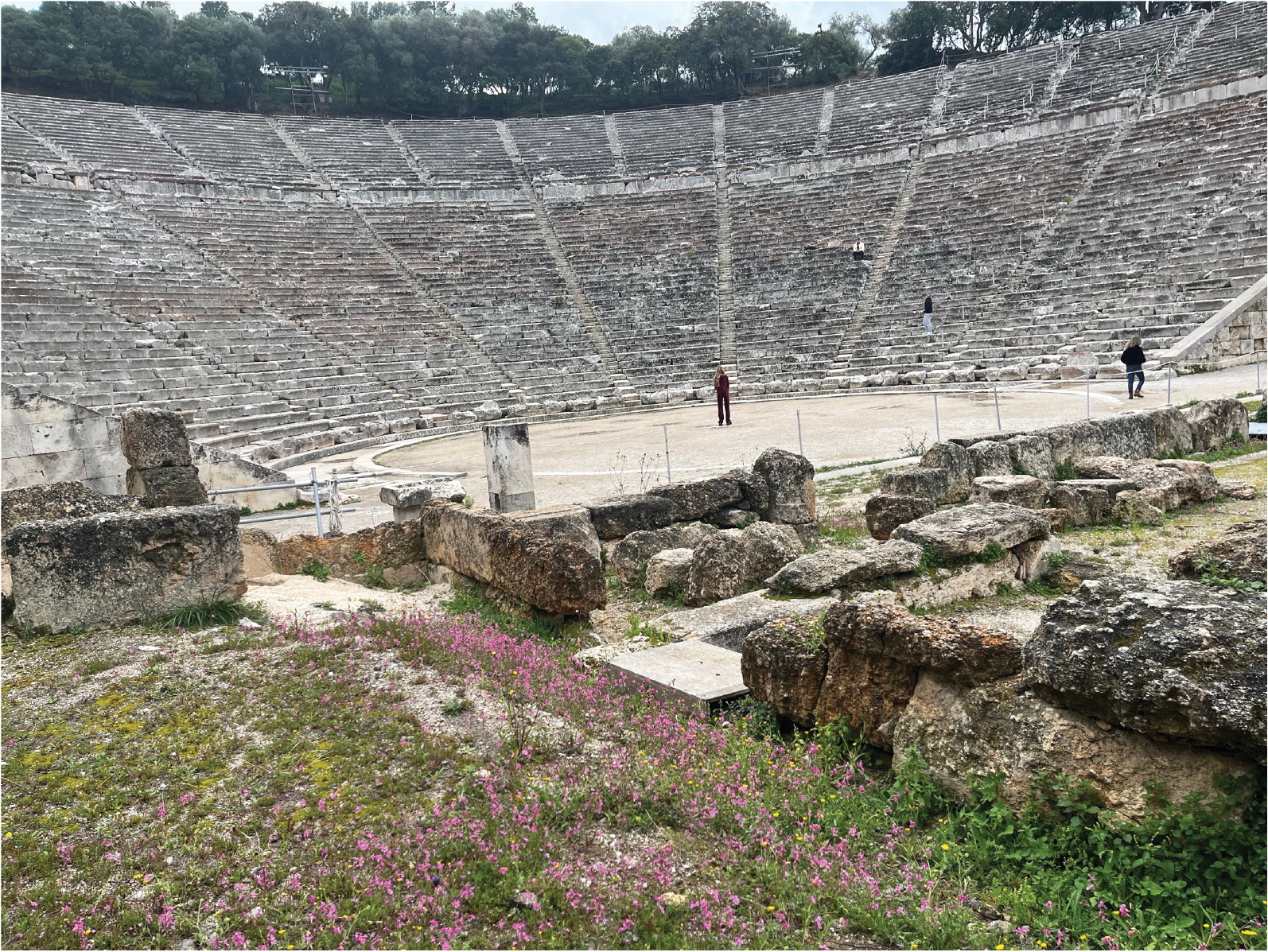
From the Source to Re-sourcing in Africa—March 2024
After leaving Greece we traveled down to South Africa, where Vivien was born and where we both have spent much time including extended Fulbright assignment periods in 2020–2021 and 2023. This country, like Israel, feels like a second home to us with its large web of family, friends, and professional colleagues. “Coming home” to South Africa has generally proved to be regenerative for us. However, now South Africa in general has played an active and controversial role in the current Middle Eastern war and is known to have taken an anti-Israel stance. Therefore, it was with a heavy heart that we approached Johannesburg, laden with the complexities of decolonialism and the current rampant antisemitism that is unfolding here, despite the active role that South African Jews have played in supporting the struggle for freedom from apartheid. What we found on this trip was a mixed blessing. On the one hand, the fruits of the Fulbright sojourn had resulted in the establishment of Africa’s first Post Graduate Diploma in the Arts (PDGA) program in Dance, Education, and Cultural Contexts. Vivien was delighted to teach the entering group’s first cohort in the Drama for Life (DFL) program at the University of the Witwatersrand (see Figure 4).
FIGURE 4 | Vivien Marcow Speiser with the first PDGA cohort at the University of the Witwatersrand. Photo, Linda Mdena, March 6, 2024.
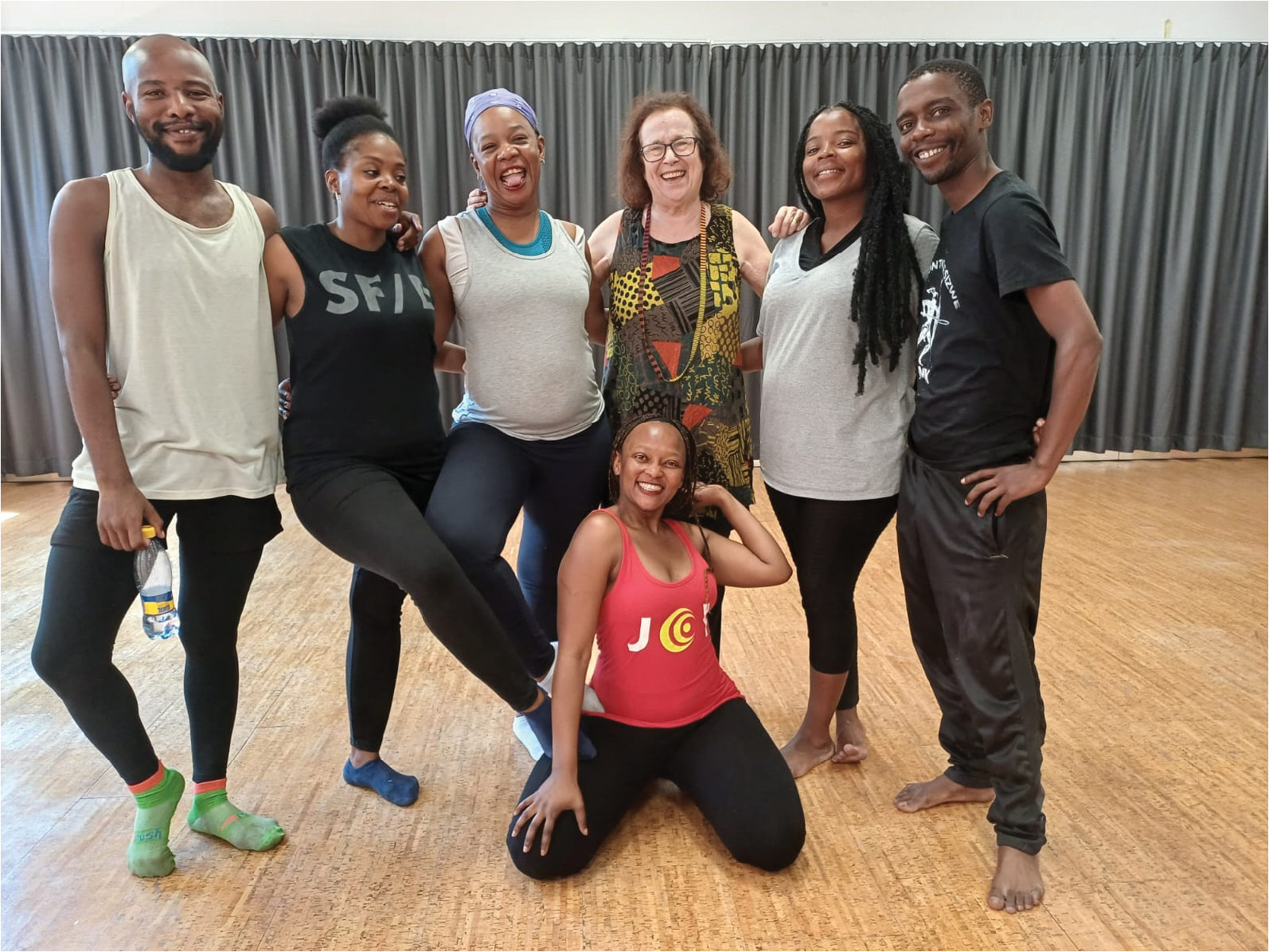
In previous trips to South Africa we had been struck by the spirit of Ubuntu, the phenomenon that recognizes a sense of seeing one another and that “what happens to me happens to you,” that permeates the culture. We had written about this sense of seeing and being seen on previous trips as follows:
Here lies a different kind of recognition of what is going on for all of us. We are re-minding and re-bodying ourselves into a larger sense of togetherness deriving from an Ubuntu sense of community interdependence—a larger sense of belonging. We are entering another kind of dimension that we can tap into. A liminal, in-between dimension in which the arts reside, that artists bring forward and make available to us (Speiser and Speiser, 2022, p. 76)
On this trip to Johannesburg, however, we did not feel nourished by the protective feeling of safety in being and bearing witness. We were nearly mugged twice on the same day walking in a “safe,” well-populated area, and both of us managed to get sick before we left. The feeling of togetherness and belonging somehow to the culture that had always worked as a protective resource for us was no longer working in the same way until after we left South Africa and moved on northward to Lusaka, Zambia.
The IMPAC 2024 Symposium and Festival at Open Windows University (OWU), Lusaka, Zambia—March 20–24, 2024
Once we were ensconced in Lusaka we began to settle in and once again felt a sense of being witnessed and held in community that reassured us. Working together with our distinguished colleague Nsamu Moonga, we presented a pre-symposium training and workshop for professionals in the fields of health, education, community, and therapy. In addition, we three were the featured keynote presenters at the groundbreaking symposium that addressed some of the interdisciplinary aspects of the applications of the creative and expressive arts in therapy, education, and community as these have evolved internationally and are practiced within the Zambian and Southern African context. Vivien had received a Fulbright Specialist award to work with Open Windows University in the investigation of the potential for the development of an academic curriculum for creative and expressive arts therapy drawing upon our understanding and experiences from around the world in the service of academic program development and implementation. As Vivien has observed in relationship to program development in the Southern African context: “Traditional approaches may no longer suffice, requiring a fresh perspective on giving birth to new initiatives. This process mirrors the creative act itself, where artists embrace the unknown and ambiguity as integral to creation” (Speiser, 2023, p. 197).
We learned from our work in Zambia that the arts there are woven into wider patterns of connection and communication that permeate the culture across the linguistic, tribal, and ethnic divides. The visual and spoken arts, music, dance, and embodiment are used in the rituals of social engagement with traditional ceremonies held for individuals and groups as a way of marking passages such as transitions in the life cycle; bindings such as weddings; separations; life stage passages such as initiation ceremonies; and occasions for collective healing. Such ceremonies can include prayers for rain, the cleansing of evil spirits, spiritual benevolence, the healing of illness, and a way to relate to individual and collective phenomena and experiences including natural and supernatural circumstances and powers. The arts constantly celebrate and affirm the vibrancy of life itself and are embedded in the generational passage not only of time but of the very nature of the social fabric in African life. The proposed development of creative and expressive arts programs in Zambia through Open Windows University auspices intends to build sophisticated and civic-minded graduates who are able to respond to psychosocial challenges in a globalized environment through the use of the arts in education, therapy, community, and health. The program would be designed to develop students’ creative, imaginative, and critical knowledge and skills, along with academic research capabilities within the domains of the arts. In keeping with the University’s focus on promoting African scholarship, this program would address the need for academically sound and adept, discipline-specific approaches that are indigenous to the culture. The pre-conference workshop and the associated professional conference offered by Open Windows University will constitute the academic launching of conversations and engagements toward a professionalization of the creative and expressive arts fields in Zambia (see Figure 5). We are drawing upon the belief that the arts mobilize passions and courage in the service of our common survival and are embodying the idea that the arts can and have built bridges that cross boundaries and have the capacity to unite people through their common humanity and need for creative expression. In addition, we believe that the Creative Arts are a time-honored form of holistic medicine encompassing self-regulation and balance, creativity, rejuvenation, ritual, and healing. The focus of the workshop we led is to provide allied professionals in education, health, and mental health with an understanding of the theoretical and practical bases of the applications and uses of creative and expressive arts therapies.
This workshop is intended to strengthen the awareness, capacity, and willingness of healthcare institutions to incorporate the arts as part of integrated care deliveries that will further quality, cost effectiveness, and patient/family satisfaction. The arts and expressive enactments are ways of “telling the story” in symbolic ways that are able to “hold and contain,” that is, to have coexisting within them complex and at times contradictory elements. The telling of stories and the expression of personal narratives through a wide variety of art forms to a community of witnesses can be a powerful tool for individuals to work through difficult experiences. Participants are introduced to various media (music and sound, dance and movement, storytelling, poetry, the visual arts, and drama) and their integration into professional practice. There was a focus on experience, understanding, and application of creative and expressive arts therapy techniques among a variety of clinical populations.
FIGURE 5 | IMPAC 2024 pre-symposium workshop led by Nsamu Moonga and Vivien and Phillip Speiser. Photo, OWU March 20, 2024.
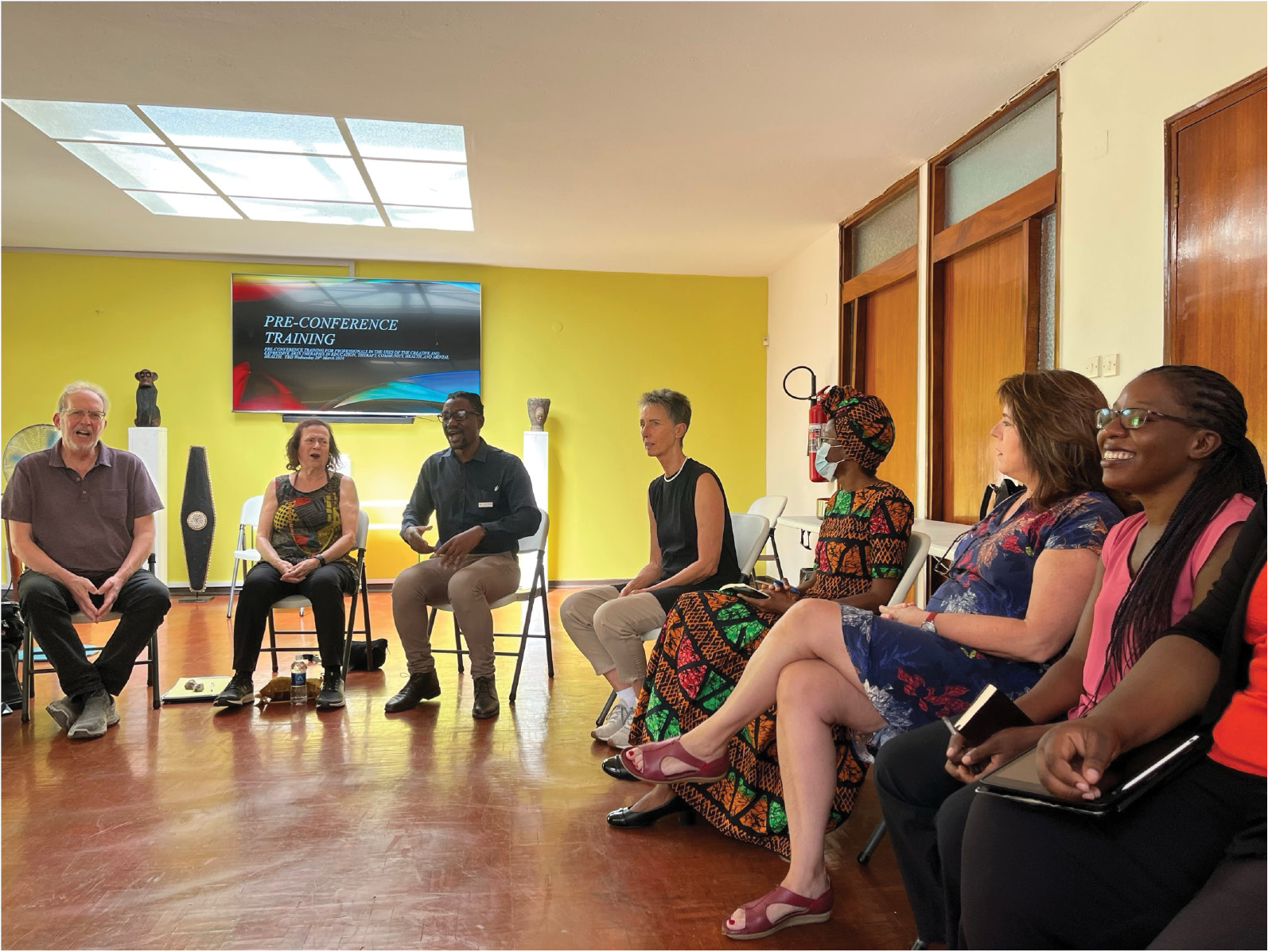
Moving Deeper into Africa where Nature Re-sources Us
From Zambia, we fly to Tanzania where we will witness the great herd migration where hundreds of thousands of mostly zebra and wildebeest cross annually from Kenya down to Tanzania for half the year, where they birth their young, and those that survive then make the trek back north (see Figure 6). These vast migratory herds are always searching for the best food and water in this never-ending circulatory journey where they are themselves encircled by predatory beasts as they attempt to protect their young and stay alive themselves. It is a curious moment where we are, taking respite from the wars by bearing witness to an essential search for survival in the animal kingdom. We become tourists as part of the herds of tourists in the Serengeti park, who encircle the animals engulfed in this migratory pattern. We too are trying to survive the danger to the human species posed by conflict, war, and ecological threats. We are finding here that nature re-sources us, and we feel the magnitude of the connection to the whole of creation—in the constant changing vista of nature’s unfurling its treasures as it soothes us in its dust and endless joggling of game drives and searching the landscape to yield us its bounty in replenishment.
FIGURE 6 | Vivien and Phillip traveling through the middle of the great herd migration. Photo, Phillip Speiser, March 29, 2024.
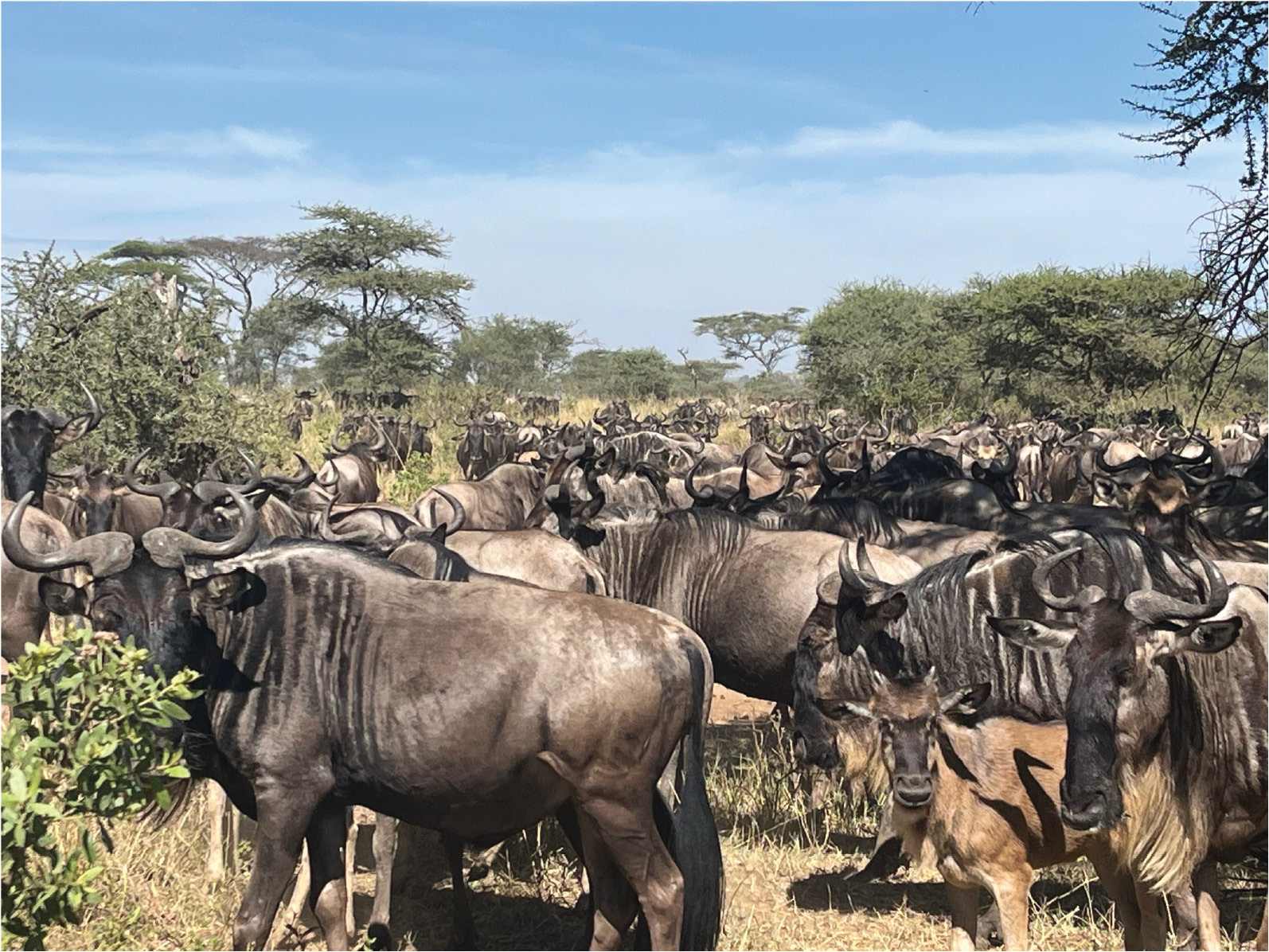
This interlude, this dance of life and death is both thrilling and totally engaging—we witness them as they witness us. We are all encircled by the predatory lions. From Serengeti, we descend through the layers of clouds into the Ngogora National Park. The dark yields to the light, and as we descend we see hundreds of thousands of flamingos line the shore of the lake. We then pass into the magical kingdom of the Masai tribes who live there. Vivien is handed a ceremonial elders talking stick by the woman who has beaded and blessed the stick (see Figure 7). It is the kind of female elder talking stick that Vivien has searched for perpetually and it finds her in precisely the right moment in time. Vivien will use the talking stick in ceremony with the groups she works with hereafter.
FIGURE 7 | Vivien being handed the female elder talking stick. Photo, Phillip Speiser, March 29, 2024.
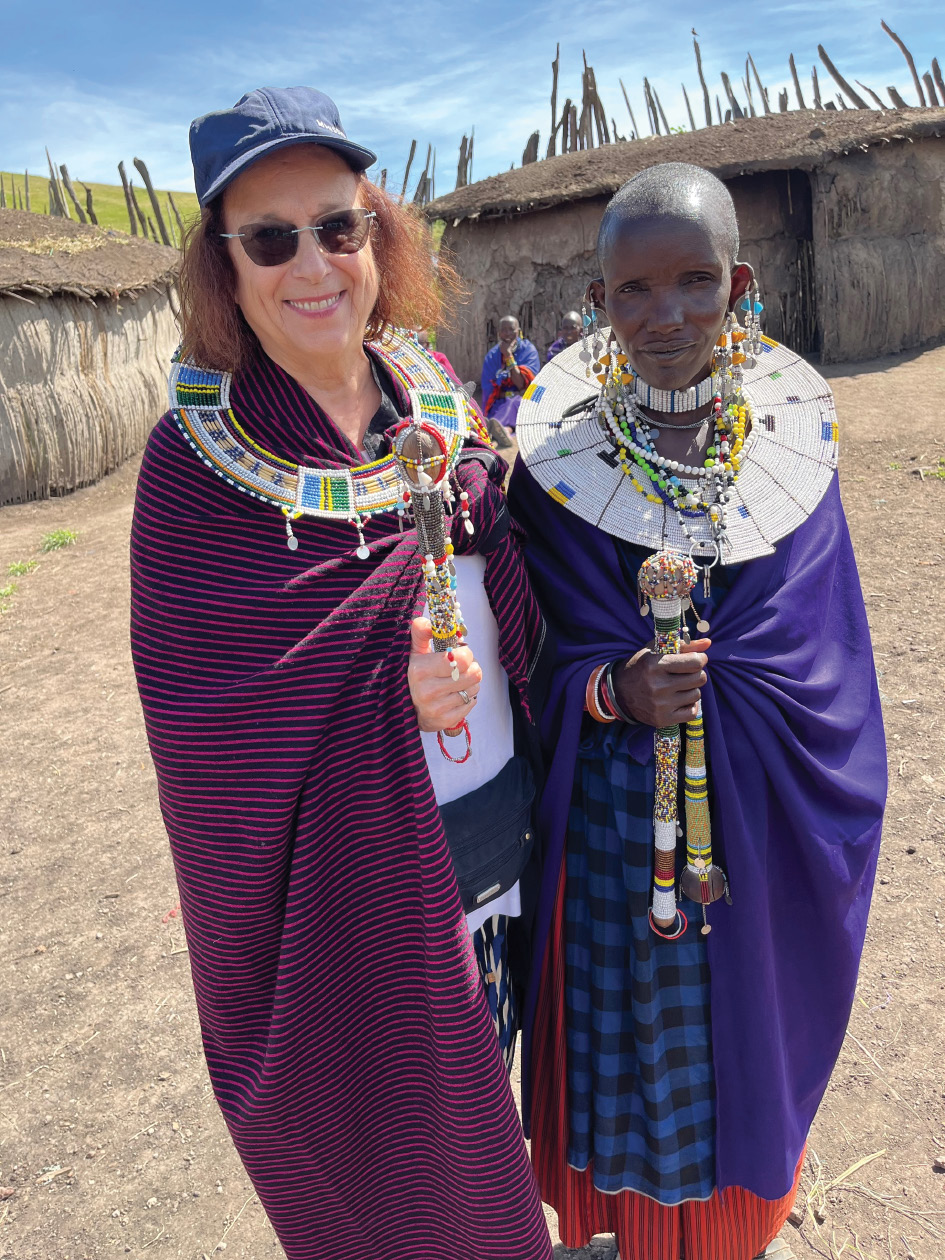
And so, as the sun begins to set on our time in Africa, we carry within us the blazing glory of the red earth, the majesty of sky and mountain, the timeless continuity of animals seeking sanctuary, the magnificence of flamingos in flight, the endless opportunities that nature, the arts, and our own creativity facilitate in us as we move on.
Mumbai—the Creative Mélange—March 2024
After leaving Africa, we arrive in Mumbai, India, where the colors, the sounds, the images and the hustle and bustle of this city invigorates us into an altered state of consciousness. We begin to feel a different kind of nurturance at work here. We feel we are a part of all this constant flow of sensory experience and constant stimulation. We feel welcomed and accepted here as part of the human family. We are delighted by all we see and do. We reunite with our dear friend and colleague Devika Mehta, who we have known now for many years in many Zoom meetings and across so many continents, but we are now finally meeting her in person. We can hold and hug her in real flesh and blood, time and reality. We meet some of her students in the workshops we conduct at St Xavier’s College, where Devika so ably directs the expressive arts therapy training program (see Figures 8a, b, and c). We pass around the African female elder talking stick in the circle to our students in Mumbai in a ritual of initiation. We embrace and are embraced by the holding that art creates.
FIGURE 8a, b, and c | Vivien and Phillip with Devika Mehta and students. Photo, St Xavier’s College, April 7, 2024.
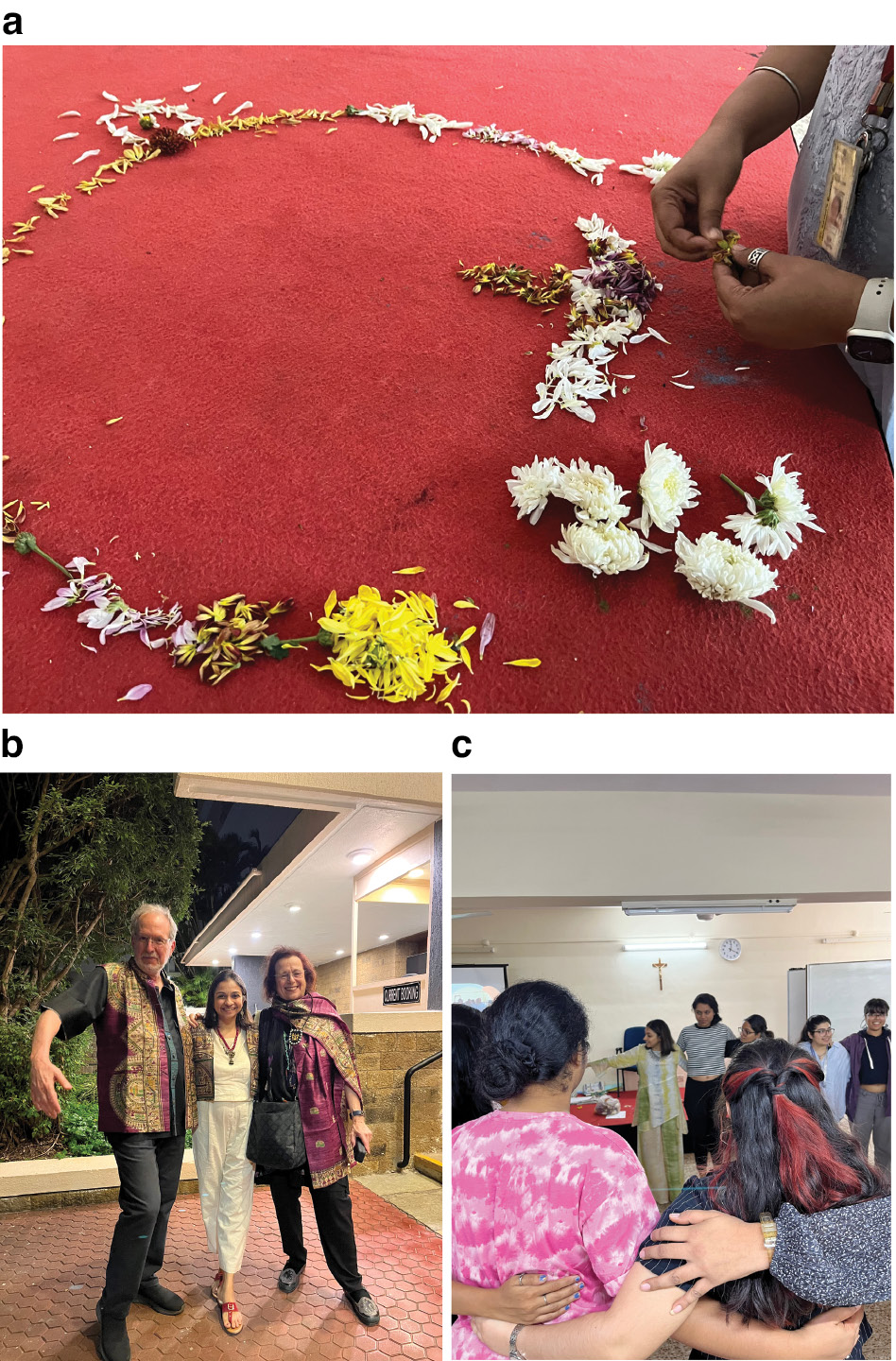
There is a timeless appreciation for the arts here, from the ancient healing rituals of celebration, of worship, of religious devotion, the streets are alive and bursting with motion and a cacophony of images and sounds—a city, it seems, that never sleeps. It seeps into everything we do. We come back to the hotel in the evening after a long day of touring and teaching and we are offered a warm flower-full bath of water to soak our feet in. We are re-sourcing again the sights, the sounds, the colors, the friendships, and the festivities. The arts are surrounding us and seeping into our very pores. We do not have to explain the integration of the arts to this audience. We are all living testament to the abundance that art offers. Even though there are close to 22 million people in Mumbai and even though we have traversed many miles, this city feels like a village that is accessible and friendly. Mumbai is suffused in vibrancy, vibrancy of color, expressive and emotional vibrancy, and an abundance of curiosity about us. The wars seem long ago and far away, and we are delighted with what we have found here. We feel sourced and re-sourced from our sojourn in Mumbai.
On to Shanghai—April 2024
We leave Mumbai for Shanghai and find ourselves transported to another universe entirely. We are immediately struck by the immensity of this city as it spirals upward into the sky. With a population of nearly 30 million people, just traveling from the airport to our hotel feels like we are traversing an endless skyline of high-rise buildings, their lights twinkling into the milkiest of ways. Thankfully we are staying in the French concession area, which feels more accessible and closer to earth as we know it. Although the area is ringed by taller buildings, we are encased within canopies of flowers, blossoms, trees, and smaller buildings and parks. We breathe a deep sigh of relief as we begin walking some of these seemingly endless distances around us. There is a feeling of space around us that allows us to approach this vast city with curiosity, with time to explore and understand the culture better before we move on to teaching in Beijing.
We meet with our colleague Professor Jun Hu from Hangzhou Normal University in an exquisite restaurant in Shanghai where we are replenished in body, soul, and spirit (see Figure 9). We know Jun Hu from working with him in IACAET webinar events and as a coeditor with Vivien in the CAET Journal. It is such a pleasure to meet him in the exuberance of his real flesh and blood presence. We are instantly enraptured in the energetic flow of exchange and ideas at the same time that our bodies are absorbing the tastes and textures of our conversation and the array of dishes we are eating. In his writing, Jun Hu has observed that “I assume that art education may be re-conceptualized within a logic that makes possible an improvisational creativity without conscious purpose of the artist beforehand and that teaching as such could be conducted without an art teacher, or a community art project without an organizer.” (Hu, 2021, p. 26) This is a motif that is resonant with our belief and understanding of what we are presently doing in meandering through countries and situating ourselves in nature, in art, in relationships, in this moment of lunching together with our colleague. We are preparing ourselves for teaching in China. We will soon be teaching in the inaugural Inspirees Institute Expressive Arts Therapy training program (see https://www.inspirees.com/inspirees-launch-expressive-arts-therapy-training-program/), and our engagement with our colleague will prove to be instrumental in allowing the spirit of Tao to inform our teaching praxis as we introduce the field of expressive arts therapy in China.
FIGURE 9 | Vivien and Phillip feasting on a banquet of food and conversation with Professor Jun Hu in Shanghai. Photo, source not known, April 15, 2024.
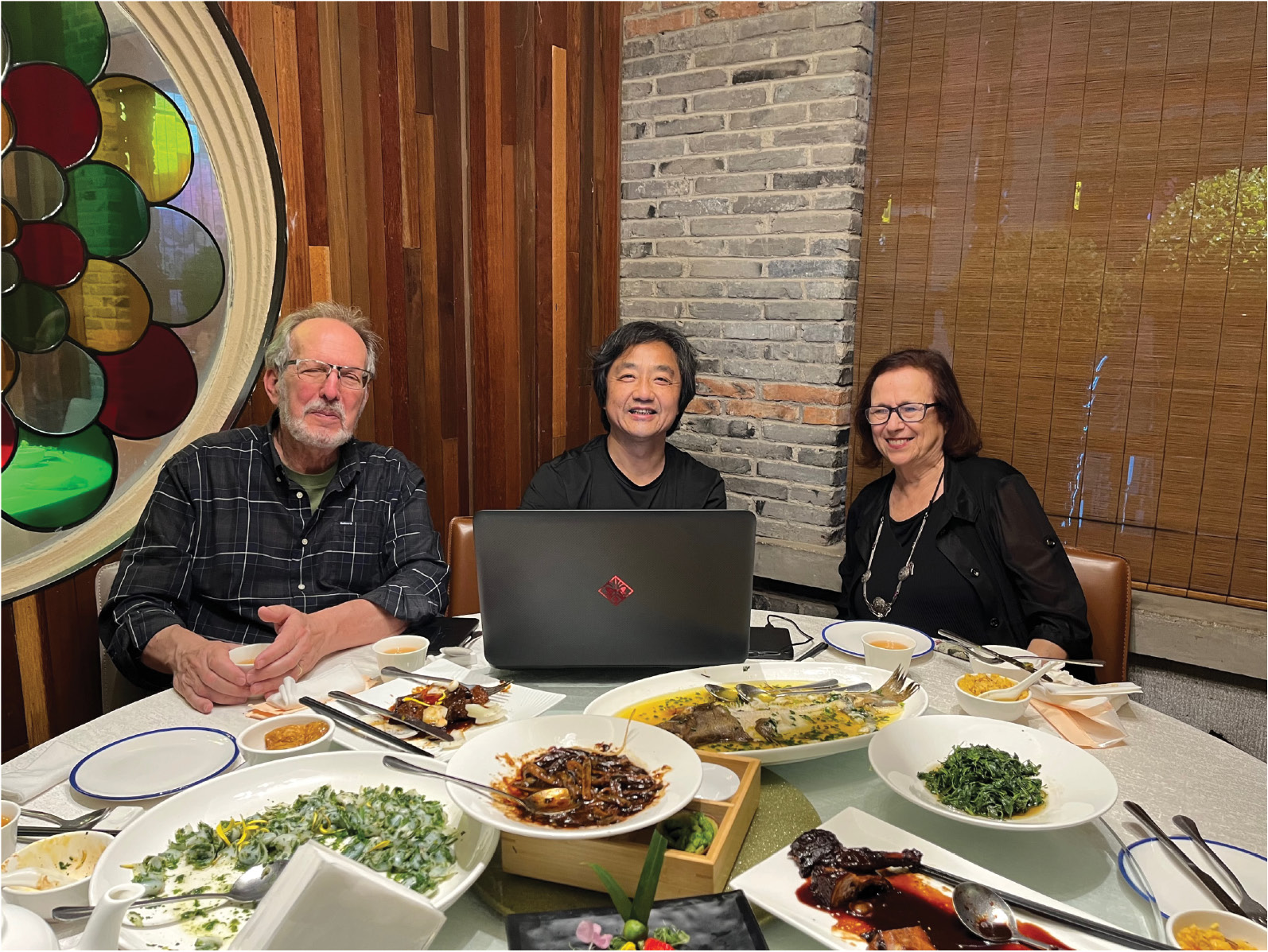
Teaching in Beijing—April 2024
We fly from Shanghai to Beijing. Arriving at the teaching site that is housed in a natural environment outside of the city, we allow the ambience of the small lake, the trees verdant with blossoms, and the sounds of birdsong to enter and permeate our senses. This is an important moment, an entrance portal into which we are entering as we prepare for the emergence into shape and form of a template for how this field of expressive arts therapy will evolve in China. We have done this before in many countries over many years. Our work as expressive arts therapists began when we entered the field in the inaugural classes at Lesley University as students in the mid-seventies. It is now nearly 50 years later, and if we add our combined experiences together we have close to 100 years of working with the expressive arts therapies. This is a moment to pause for reflection and celebration as the work moves into China.
Phillip was instrumental in the development of the field in Scandinavia, and Vivien, for the development of arguably the largest expressive therapy training program in the world that she led in Israel from 1980–2014, as the expressive arts therapy field spread and permeated across the globe. This international program development work has been well documented in several publications including Speiser and Speiser (2023) and Schwartz et al. (2012). Vivien (Speiser, 1995, 1998) has attested to the importance of commemoration in her work with ritual, and we are about to embark on a rite-of-passage process for the entry of the work in China.
We know that this group we are teaching is the first inaugural training group and that they, in many ways, will become the standard-bearers for the profession as it develops in China (see Figures 10 and 11). For the next several years they will engage, together with the faculty, in adapting the form of expressive arts therapy to their specific personal and professional needs, abilities, and frameworks of operation. We hope to impart to them the creativity and capacity for lifelong development they are embarking upon in their choice of career in this wide-open field. We channel the spirit of one of our mentors, the late, magical Norma Canner, one of the early expressive arts therapy pioneers, who more than anyone else taught us that there is no one way to do expressive arts therapy (see Beardall et al., 2014). Like Norma, we have always taught our students that there is no right and no wrong way to practice the form of expressive arts therapy. Each of us brings our personal trajectory and professional and arts background with us into the work in engagement with our own creative process, which allows for growth and development as only each individual can grow, that is, in their own way. Norma once said in private conversation with us: “First you try one thing, if that does not work, then you try another thing, and the rest will follow….” This is what we hope to impart to our first group of students as they and we start to find our way in adapting and creating the form of expressive arts therapy as it will come to be practiced within China. We remain as motivated and as curious as the students are to bear witness to its unfolding into form.
We open into the circle with curiosity, ceremony, and commitment. Here we are, sitting together in the circle. We reach out our hands to one another, we honor our ancestral lineage, we open to the companionship of community, we pray to sky, to the great unknown, to the enormous contribution each member of this group will make to themselves, to each other, and the burgeoning expressive arts therapy field itself, wide as sky. We feel that we have come full circle from north to south and from east to west, the world is wide open, and we are on it. We have learned over and over again that the arts both reflect and at the same time transcend cultural boundaries. The communication is hands to our own hearts, holding ourselves and our personal history close while at the same time reaching out to the great potentialities and possibilities inherent in humans, spirit and nature. Art can transcend the geographical, the geopolitical, the divides, the obstacles created by power, warfare, and all that would divide us as art mirrors back to us the wholeness and transcendent power of infinite creativity that is our salvation.
FIGURES 10 AND 11 | The first Inspirees Expressive Arts Therapy group inaugurates the training program, April 2024. Photo, Inspiree, April 19, 2024.
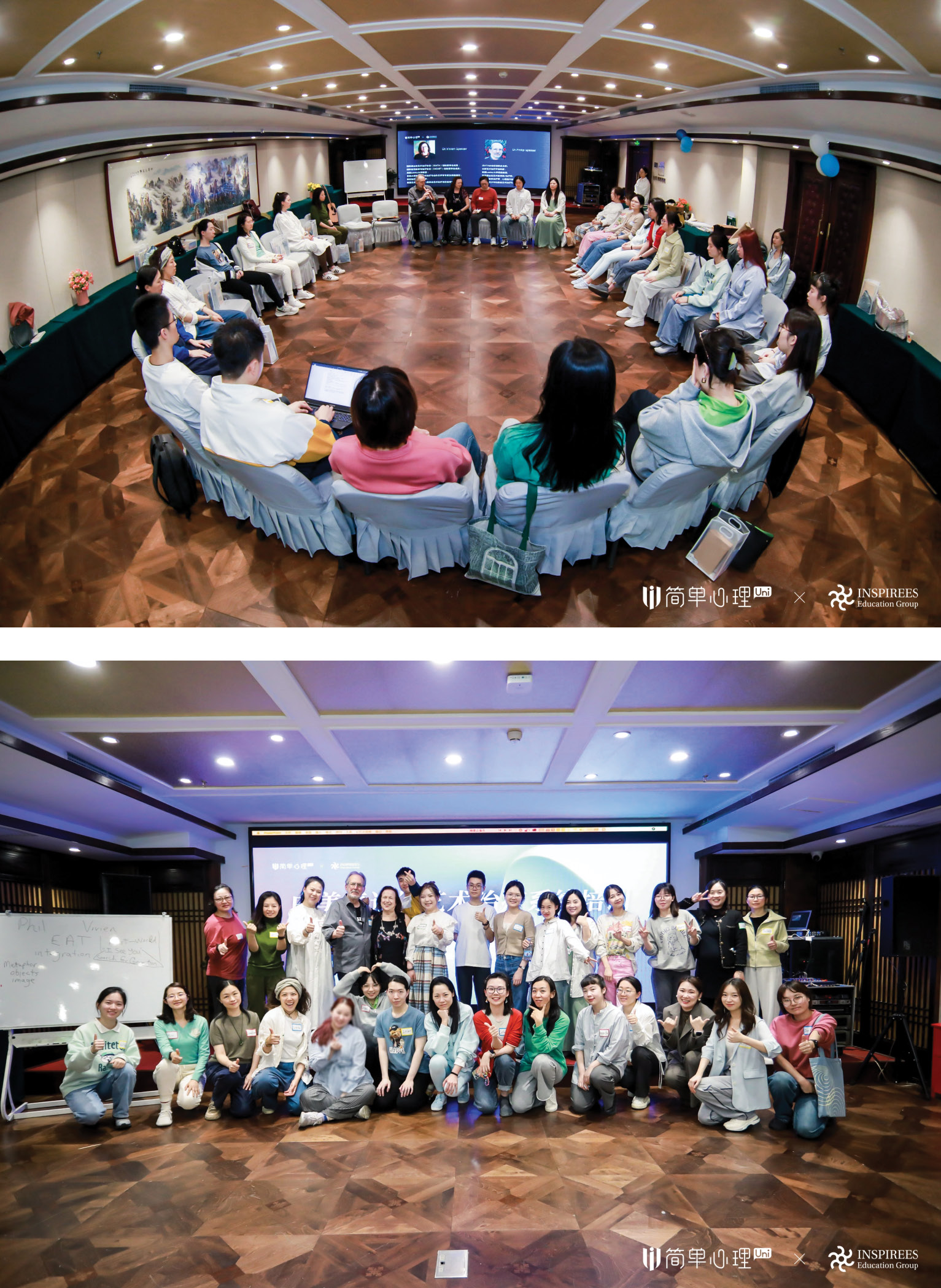
Conclusion
Our journey is nearing its end. We are in the process of our return to the USA. In Beijing, we are now at our furthest distance from home, from the known and the familiar. We were exhausted emotionally and close to burnout as we began our travels in February 2024. The terrain we have traveled has taken us across five continents and has renewed our faith in the power of the arts for respite, restoration, recuperation, and recovery. Like the Gestalt therapists opined back in the 1960s, “we have lost our minds and come back to our senses.” We offer thanks to all the friends and colleagues we have encountered in this journey. To the lands we have traversed, the students who have taught us about the necessity of being here now in the moment, who have allowed us into their interiorities, to witness us bearing witness to them, their engagement in the arts, their relationality, their capacity to sojourn with us. The wars remain in us and with us and art allows us to internalize and experience and to continue to co-exist in many other contexts, as fully as possible in any given moment. It does not offer a magic panacea, but we are now sensitized enough to creativity, to beauty, to suffering, and to remaining as present as is possible moment to moment. We raise our hands in supplication and in prayer.
We conclude with these words from Rainer Maria Rilke:
You have not grown old, and it is not too late
To dive into your increasing depths
where life calmly gives out its own secret…
Let everything happen to you: beauty and terror
Just keep going. No feeling is final.
Don’t let yourself lose me.
Nearby is the country they call life.
You will know it by its seriousness.
Give me your hand.
― Rilke (1996, 2005) Rilke’s Book of Hours: Love Poems to God (p. 119)
About the Authors
Vivien Marcow Speiser, Ph.D. LMHC, REAT, BC-DMT, is a Professor Emerita and Co-Director of the Institute for Arts and Health in the Graduate School of Arts and Social Sciences, Lesley University. Professor Marcow Speiser has directed and taught in programs across the United States and internationally and has used the arts as a way of communicating across borders and across cultures. She believes in the power of the arts to create the conditions for personal and social change and transformation.
Her interests and expertise are in the areas of working with trauma and cross-cultural conflict resolution through the arts, and she has worked extensively with groups in the Middle East and in South Africa. Her contributions to the field have made her an international leader in dance and expressive therapy and earned her Fulbright Scholar Awards in 2020 and 2023, as well as a Salzburg Global Seminars Fellowship in 2020.
She received an honorary JAAH Lifetime Achievement in Arts and Health Award in 2019, the 2014 Distinguished Fellows Award from the Global Alliance for Arts and Health, as well as a 2015 Honorary Lifetime Achievement Award from the Israeli Expressive and Creative Arts Therapy Association.
Author to whom correspondence should be addressed; E-Mail: vspeiser@lesley.edu; ORCID ID: https://orcid.org/0000-0001-5107-7954
Phillip Speiser, PhD, REAT, RDT/BC, is an artist, expressive arts educator/therapist, drama therapist, and psychodramatist who has developed integrated arts therapy, wellness/health, and educational programs for over four decades. He is currently Director of Parkside Arts and Health Associates in Haymarket, Virginia, where he does supervision and project development around the globe. He is also a research associate at the University of the Witwatersrand and lecturer at the art therapy program at the University of Johannesburg. After the tragic events of 9/11, he developed the “Healing Arts Project,” a trauma recovery/prevention program in Boston and New York City.
Author to whom correspondence should be addressed; E-Mail: pspeiser@gmail.com; ORCID ID: https://orcid.org/0000-0001-6688-9365
References
Abram, D. (1996). The spell of the sensuous. New York: Random House.
Beardall, N. G., Brownell, A., Cardillo, N. J., Harmel, P., Karman, S., Marcow-Speiser, V., Newman-Bluestein, D., McKim, E., & Smulian-Siegel, D. (2014). The legacy of Norma Canner. American Journal of Dance Therapy, 36(1), 113–124.
Dewey, J. (1934). The arts as experience. New York: Perigree Books.
Hu, J. (2021). Rock balancing land art: A more-than-human approach. Creative Arts in Education and Therapy, 7(1), 26–33. https://doi.org/10.15212/CAET/2021/7/9.
Inspirees Institute. (n.d.). Inspirees launch expressive arts therapy training program. https://www.inspirees.com/inspirees-launch-expressive-arts-therapy-training-program/.
Rilke, R. M. (1996, 2005). Rilke’s book of hours: Love poems to god (A. Barrows & J. Macy, Trans.). New York: Riverhead Books.
Schwartz, S., Marcow Speiser, V., Speiser, P., & Kossak, M. (Eds.). (2012). The arts and social change: The Lesley University experience in Israel. Israel: Porat Books.
Speiser, V. M. (1995). The dance of ritual. Journal of the Creative and Expressive Arts Therapies Exchange, 5, 37–42.
Speiser, V. M. (1998). The use of ritual in expressive therapy. In A. Robbins (Ed.), Therapeutic presence. Bristol, PA: Jessica Kingsley.
Speiser, V. (2023). Voices from the field: Investigating the emergent form of an indigenous dance movement therapy training program in South Africa. Creative Arts Education and Therapy, 9(2), 195–208. https://doi.org/10.15212/CAET/2023/9/11.
Speiser, V. M., & Speiser, P. (2005). A theoretical approach to working with conflict through the arts. In V. Marcow Speiser & C. Powell (Eds.), The arts, education and social Change. Peter Lang.
Speiser, V. M., & Speiser, P. (2007a). An arts approach to working with cross cultural conflicts. The Journal of Humanistic Psychology, 47(1), 361–367.
Speiser, V. M., & Speiser, P. (2007b). The use of the arts in working with fear and stress in the Israeli context. In The Praeger series in body–mind medicine: The art of healthcare (Vol. II).
Speiser, V. M., & Speiser, P. (2022). There are no silos when we are all suffering: Interviews and reflections on ubuntu and the arts in South Africa during COVID-19. Creative Arts Education and Therapy, 8(1), 71–88. https://doi.org/10.15212/CAET/2022/8/2.
Speiser, V. M., & Speiser, P. (2023). Journeying with Shaun McNiff: Entering the slipstream in the right moment in history, trusting the process and letting conflict define. Journal of Applied Arts & Health, 14(issue Celebrating Shaun McNiff), 305–314. https://doi.org/10.1386/jaah_00143_1.
Walsh, N. D. (2001). What is the proper response to hatred and violence? In From the ashes: A spiritual response to the attack on America. St. Martin’s Rodale and Beliefnet.